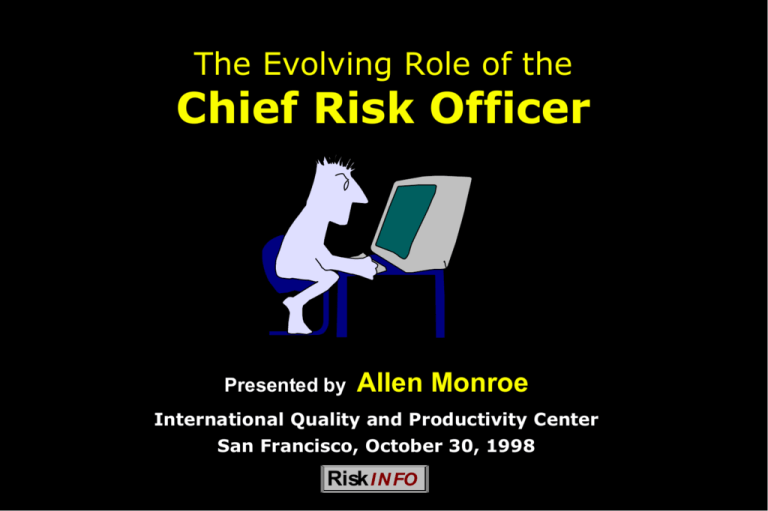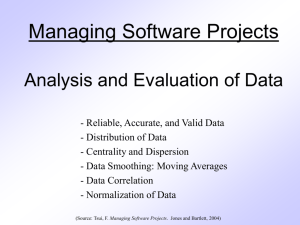presentation source
advertisement

The Evolving Role of the Chief Risk Officer Presented by Allen Monroe International Quality and Productivity Center San Francisco, October 30, 1998 Risk I N FO Session Objectives Review Need for integrated risk management approach Review a Unified Conceptual Framework that applies to all types of risk Show how to leverage contemporary technologies to achieve integrated risk management. Risk I N FO I. The NEED for Integrated Risk Management Would you accept with 100% certainty: Your Sales Director’s contention that sales will increase 20% next quarter because the product you are about to introduce “beats the pants off the competition?” • Your Nuclear Engineer’s contention that, because of redundant systems, there is no chance of an accident that would result in explosion of release of radioactivity? • Risk I N FO Most Jobs have a Singular Objective Maximize sales. Cut expenses to the minimum. Get the new product to market on time. Meet the quarterly budget forecast. With such single-minded objectives, WHO is weighing the tradeoffs? Risk I N FO The “Textbook” Approach Five-step risk management process: • Identify risk exposures • Quantify risks • Avoid and Transfer risks through safety, engineering, contractual, and other means. • Retain those risks which remain to the extent they are within the organization’s financial capacity • Insure risks above the organization’s own retention capacity. Risk I N FO Shortcomings of Textbook Approach What if insurance is currently priced at less than the “burn rate?” (expected losses) What if insurance is not available, or appears to be very expensive for certain risks or certain limits? What if the rate of return on loss control investments fails to meet company targets? • With these thoughts in mind, let’s turn to a Unified Conceptual Framework that applies to all types of risk. Risk I N FO II. Seeking a new definition of Risk Old distinction between insurable risk and “business risk” is becoming blurred. Fortuitous risks and non-fortuitous risks not always separable Defining risk as the “chance of loss” ignores the fact that frequency of small losses can add up to a fairly predictable annual cost. Risk I N FO Understanding Risk from a Financial Perspective Financial theorists define risk as: • Uncertainty as to achieving an Expected Outcome, observed through: • Variability from an Expected Result. Risk I N FO Risk is Integral to all Economic Activity The VALUE of an investment, such as a company’s stock is: Based both on the • Amount of the Estimated Future Earnings Stream, and the • Degree of Uncertainty in realizing those estimated earnings. Risk I N FO Valuation Formula Value = E arnings 1...n __________ Required Rate of Return Risk I N FO Components of ROI Analysis of Risk Reduction or Transfer Expenditures Stream of after-tax Revenue over time = each year’s Net Expected Savings attributable to Risk Reduction Importance of Timing Importance of after-tax Discount Rate Risk I N FO Effect of Risk Reduction Expenditures on Valuation Formula Cost of Risk Transfer = “Premium” less “Expected Losses” “Benefit” of Reduced Risk translates into a lower Required Rate of Return “discount” factor applied to the stream of future earnings. Net Benefit of Risk Reduction or Transfer expenditure is the combined effect on V=E/R. Net Risk I N FO Example Before Risk Reduction: • Present Value of $1 billion annual after tax income for 30-yr. horizon / .09 required rate of return = $10.27 billion. After Risk Reduction: • Present Value of $.95 billion annual after tax income for 30-yr. horizon / .085 required rate of return = $10.61 billion. Decision: Yes, proceed with risk reduction. Risk I N FO Effect of Differing Risk Characteristics affecting Economics of Risk Transfer Principal • • • • Risk Characteristics: Frequency of Loss Average Severity of Loss Degree of “Internal” Correlation with other risks Relative “External” (I.e. Insurance or Capital Markets) risk correlation. These factors affect the cost and benefit of risk transfer. Risk I N FO Typical Risk Characteristics Workers Compensation: • High frequency, low severity, good internal correlation except for persistent exposures, good relative external correlation except for long-tail exposures. General Liability • Medium frequency, potentially high severity, moderate / high internal correlation, good relative external correlation. Property • Low frequency, high potential severity, general lack of internal correlation, excellent relative external correlation. Currency Risk I N FO Risk I N FO III. Leveraging Technology to achieve Integrated Risk Management Scott McNealy: “The network is the computer” Ability of HTML web pages to connect to any other computer connected to the Internet One web page can draw data or applications from many computers at the same time. Risk I N FO Consequences of the new Technologies Integration of differing types of data from varied systems can be achieved at much lower cost than previously. Routine tasks of gathering information, processing transactional data, and reporting are becoming less demanding. More attention is given to strategic risk management. Risk I N FO Rapid Acceptance of StandardsBased Technologies Corporate Use of email and Intranets / Extranets has reached nearly 100% in very few years. Rapid move toward embracing standards. Risk I N FO Technology enables Consolidation of Responsibility Internet Technology is highly “scaleable” Geographic location of personnel becoming much less important Risk I N FO The Power of the New Technology Makes possible a “Risk Management Control Center,” with all relevant information accessible via desktop computer. • • • • • • • Facilities database with GIS map interface Loss data and modeling tools Certificates of insurance data Insurance policy summaries Online Underwriting presentations Accident / Injury reports, OSHA 200 log Loss control / safety training via streaming video Risk I N FO Objective Achieve the best combination of risk reduction, risk retention, and risk transfer; consistent with the optimum effect on the firm’s overall Value. Risk I N FO Contact Us Allen Monroe Founder and CEO RiskINFO 234 West Baltimore Avenue Larkspur, CA 94939 (415) 927-8824 Email: allen@riskinfo.com Web Site: http:www.riskinfo.com Risk I N FO Contact Us Contact Us






